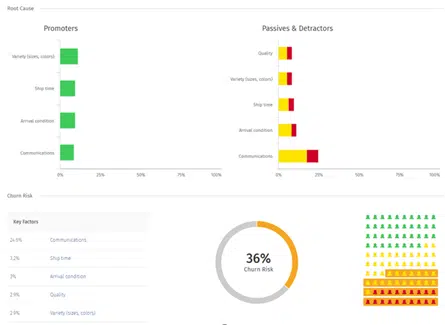CX practitioners collect a variety of metrics, including Net Promoter Score (NPS), Customer Satisfaction (CSAT), Customer Effort Score (CES) and Secure Customer Index (SCI). NPS is the metric most frequently touted, for better or worse, as the gold standard in CX measurement. Recently, there has been a lot of debate on the importance of NPS and the fear by some that companies are focusing too much on this metric, to the detriment of other customer relationship factors. However, no one seems to be vanquishing NPS to the archives of CX measurement quite yet.
NPS provides a core measurement for CX management programs for both business-to-business (B2B) and business-to-consumer (B2C). The classic example is: “How likely is it that you would recommend a [brand/product/store] to a friend.” Those people responding to the question can be grouped into promoters, passives, or detractors. While it has typically been a one question exercise, perhaps followed by an open-ended option for more information, companies are starting to look at more sophisticated NPS solutions to extract richer data from this measurement and do deeper dives into root causes.
I recently spoke with Ken Peterson, president of CX at QuestionPro while gathering background for Dash Research’s upcoming report on customer insights and feedback. As these chats often do, our conversation touched on the Holy Grail of NPS; its positive and negatives and how technology companies are supporting its collection. Ken did an impromptu demo of QuestionPro’s NPS+, which is a combination of NPS, root cause, and comment question types. NPS+ digs into the why behind the score, trying to get to the heart of the “one thing” that is behind the number. It adds just a couple of clicks to make it more robust and allows for more in-depth data that can be matched across promoters, detractors, and passives.
As an example, a person filling out a feedback form is asked a typical NPS question:

NPS+ takes the response to that question and, depending on if that person is categorized to be a promoter, passive, or detractor, they have the opportunity to identify a cause, being able to choose from a variety of options, and allowing the company to gain better insights into the original NPS score:

That one additional click also provides insights into churn risk for passives on the NPS scale.

Another interesting add-on is a voting option based on people’s responses to the question: “Give us one idea that we can do to change the game.” Respondents can see what other people have said and vote on the idea they find most compelling. In turn, the company has a view into what one thing stands out. NPS+ has been particularly popular in the retail sector, a segment looking for ways to improve both CX and operational efficiencies.
NPS is often used as a benchmark metric by companies to show how CX efforts are moving the needle. However, it is often a lagging metric and can also lack the storyline behind the score. A quality CX program should be investigating and integrating other tools and techniques to get to the “whys” behind a number so that targeted actions can be taken quickly, and customers feel heard.
Author Information
As a detail-oriented researcher, Sherril is expert at discovering, gathering and compiling industry and market data to create clear, actionable market and competitive intelligence. With deep experience in market analysis and segmentation she is a consummate collaborator with strong communication skills adept at supporting and forming relationships with cross-functional teams in all levels of organizations.
Sherril holds a Master of Business Administration in Marketing from University of Colorado, Boulder and a Bachelor of Arts in Psychology from Rutgers University.








